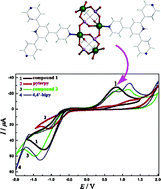N-heterocyclic amine-directed structures and properties of two Cu(ii) diphosphonates†
Abstract
By introducing the second organic N-heterocyclic

* Corresponding authors
a
Jiangsu Key Laboratory for Chemistry of Low-dimensional Materials, School of Chemistry and Chemical Engineering, Huaiyin Normal University, Huaian, P.R. China
E-mail:
kuirongma@163.com
Fax: +86 0517 83525100
Tel: +86 0517 83525100
By introducing the second organic N-heterocyclic

 Please wait while we load your content...
Something went wrong. Try again?
Please wait while we load your content...
Something went wrong. Try again?
K. Ma, F. Ma, Y. Zhu, L. Yu, X. Zhao, Y. Yang and W. Duan, Dalton Trans., 2011, 40, 9774 DOI: 10.1039/C1DT10528K
To request permission to reproduce material from this article, please go to the Copyright Clearance Center request page.
If you are an author contributing to an RSC publication, you do not need to request permission provided correct acknowledgement is given.
If you are the author of this article, you do not need to request permission to reproduce figures and diagrams provided correct acknowledgement is given. If you want to reproduce the whole article in a third-party publication (excluding your thesis/dissertation for which permission is not required) please go to the Copyright Clearance Center request page.
Read more about how to correctly acknowledge RSC content.
 Fetching data from CrossRef.
Fetching data from CrossRef.
This may take some time to load.
Loading related content
